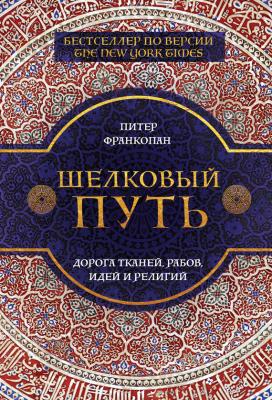Шелковый путь. Дорога тканей, рабов, идей и религий. Питер Франкопан
Читать онлайн.| Название | Шелковый путь. Дорога тканей, рабов, идей и религий |
|---|---|
| Автор произведения | Питер Франкопан |
| Жанр | Прочая образовательная литература |
| Серия | Путешественники во времени |
| Издательство | Прочая образовательная литература |
| Год выпуска | 2015 |
| isbn | 978-5-699-95706-4 |
136
G. Fussman, ‘The Mat Devakula: A New Approach to its Understanding’, in D. Srivasan (ed.), Mathurā: The Cultural Heritage (New Delhi, 1989), рр. 193–199.
137
Например, Р. Rao Bandela, Coin Splendour: A Journey into the Past (New Delhi, 2003), рр. 32–35.
138
D. MacDowall, ‘Soter Megas, the King of Kings, the Kushana’, Journal of the Numismatic Society of India (1968), рр. 28–48.
139
Обратите внимание, например, на описание в «Книге Псалмов» – «Бог Бога … Господь господствующих» (Пс. 136: 2–3, или «Бог богов и Господь господствующих» (Второзаконие 10:17). «Книга откровений» рассказывает, как зверь будет побежден, потому что Агнец – «Господь господствующих и Царь царей» (Откр. 17:14).
140
The Lotus of the Wonderful Law or The Lotus Gospel: Saddharma Pundarīka Sūtra Miao-Fa Lin Hua Chung, tr. W. Soothill (London, 1987), р. 77.
141
X. Liu, Ancient India and Ancient China: Trade and Religious Exchanges AD 1–600 (Oxford, 1988), р. 102.
142
Sukhāvatī-vyūha: Description of Sukhāvatī, the Land of Bliss, tr. F. Müller (Oxford, 1883), рр. 33–34; Lotus of the Wonderful Law, рр. 107, 114.
143
D. Schlumberger, M. Le Berre and G. Fussman (eds), Surkh Kotal en Bactriane, vol. 1: Les Temples: architecture, sculpture, inscriptions (Paris, 1983); V. Gaibov, ‘Ancient Tajikistan Studies in History, Archaeology and Culture (1980–1991)’, Ancient Civilizations from Scythia to Siberia 1.3 (1995), рр. 289–304.
144
R. Salomon, Ancient Buddhist Scrolls from Gandhara (Seattle, 1999).
145
J. Harle, The Art and Architecture of the Indian Subcontinent (New Haven, 1994), рр. 43–57.
146
См., главным образом, E. de la Vaissière, Sogdian Traders: A History (Leiden, 2005).
147
K. Jettmar, ‘Sogdians in the Indus Valley’, in Р. Bertrand and F. Grenet (eds), Histoire des cultes de l’Asie centrale préislamique (Paris, 1991), рр. 251–253.
148
C. Huart, Le Livre de Gerchāsp, poème persan d’Asadī junior de Toūs, 2 vols (Paris, 1926–1929), 2, р. 111.
149
R. Giès, G. Feugère and A. Coutin (eds), Painted Buddhas of Xinjiang: Hidden Treasures from the Silk Road (London, 2002); T. Higuchi and G. Barnes, ‘Bamiyan: Buddhist Cave Temples in Afghanistan’, World Archaeology 27.2 (1995), р. 282ff.
150
M. Rhie, Early Buddhist Art of China and Central Asia, vol. 1 (Leiden, 1999); Wei, Ancient Chinese Architecture: Buddhist Buildings (Vienna, 2000).
151
G. Koshelenko, ‘The Beginnings of Buddhism in Margiana’, Acta Antiqua Academiae Scientiarum Hungaricae 14 (1966), рр. 175–183; R. Foltz, Religions of the Silk Road: Premodern Patterns of Globalization (2nd edn, Basingstoke, 2010), рр. 47–48; R. Foltz, ‘Buddhism in the Iranian World’, Muslim World 100.2–3 (2010), рр. 204–214.
152
N. Sims-Williams, ‘Indian Elements in Parthian and Sogdian’, in R. Röhrborn and W. Veenker (eds), Sprachen des Buddhismus in Zentralasien (Wiesbaden, 1983), рр. 132–141; W. Sundermann, ‘Die Bedeutung des Parthischen für die Verbreitung buddhistischer Wörter indischer Herkunft’, Altorientalische Forschungen 9 (1982), рр. 99–113.
153
W. Ball, ‘How Far Did Buddhism Spread West?’, Al-Rāfidān 10 (1989), рр. 1–11.
154
T. Daryaee, Sasanian Persia: The Rise and Fall of an Empire (London, 2009), рр. 2–5.
155
Многие ученые писали о переменах. См. Canepa, The Two Eyes of the Earth: Art and Ritual of Kingship between Rome and Sasanian Iran (Berkeley, 2009).
156
M. Canepa, ‘Technologies of Memory in Early Sasanian Iran: Achaemenid Sites and Sasanian Identity’, American Journal of Archaeology 114.4 (2010), рр. 563–596; Weber, ‘Wahram II: König der Könige von Eran und Aneran’, Iranica Antiqua 44 (2009), рр. 559–643.
157
О сасанидской чеканке в целом – R. Göbl, Sasanian Numismatics (Brunswick, 1971).
158
M. Boyce, Zoroastrians: Their Religious Beliefs and Practices (London, 1979).
159
R. Foltz, ‘Zoroastrian Attitudes toward Animals’, Society and Animals 18 (2010), рр. 367–378.
160
The Book of the Counsel of Zartusht, рр. 2–8, in R. Zaehner, The Teachings of the Magi: A Compendium of Zoroastrian Beliefs (New York, 1956), рр. 21–22. См. также M. Boyce, Textual Sources for the Study of Zoroastrianism (Manchester, 1984).
161
См., например, M. Boyce, Textual Sources for the Study of Zoroastrianism (Manchester, 1984), рр. 104–106.
162
M. Boyce and F. Grenet, A History of Zoroastrianism (Leiden, 1991), рр. 30–33. О зороастрийских верованиях, включая молитвы и вероучения, см. Boyce, Textual Sources, рр. 53–61; о ритуалах и практиках – рр. 61–70.
163
J. Harmatta, ‘Late
